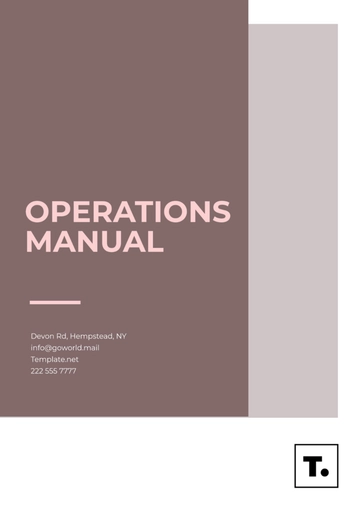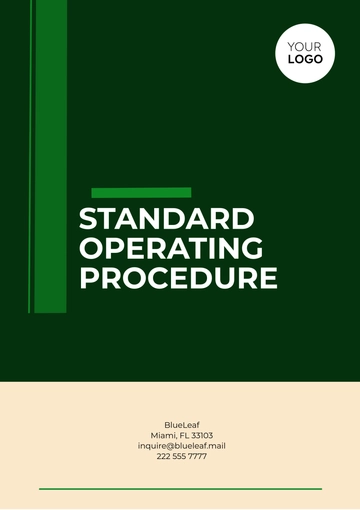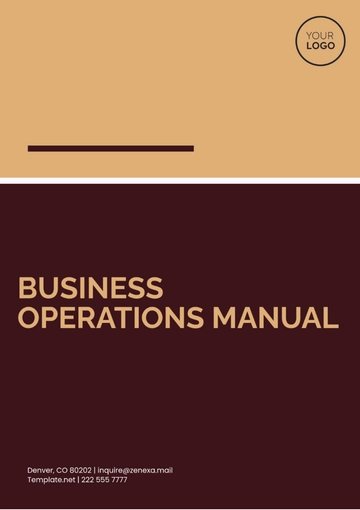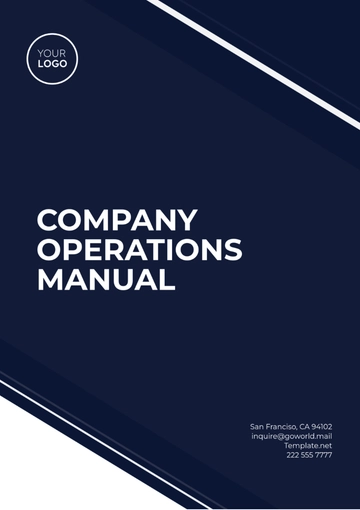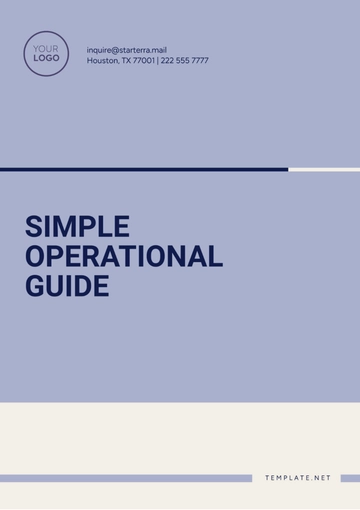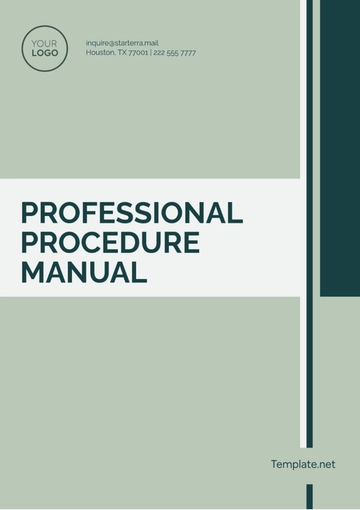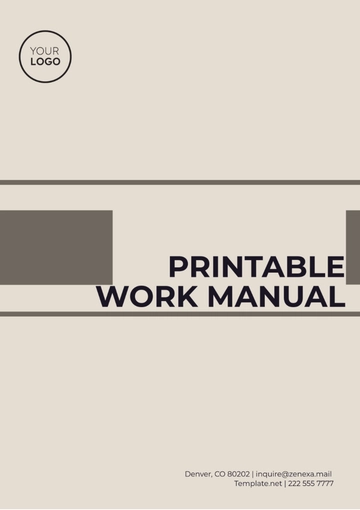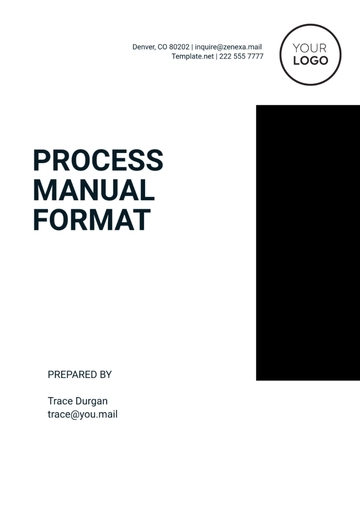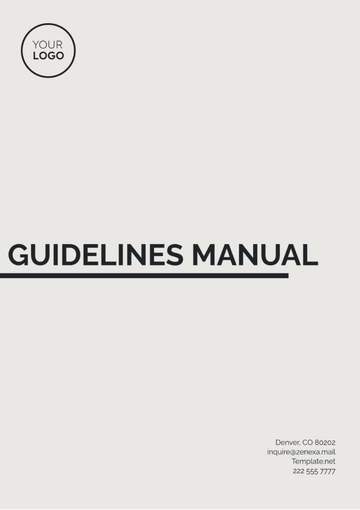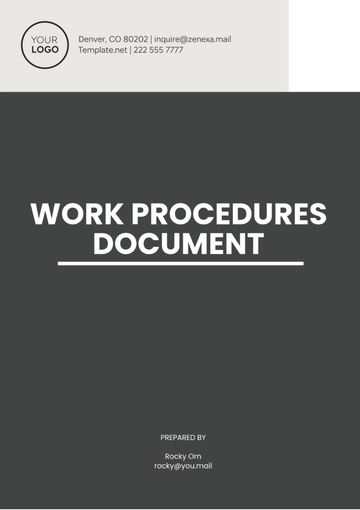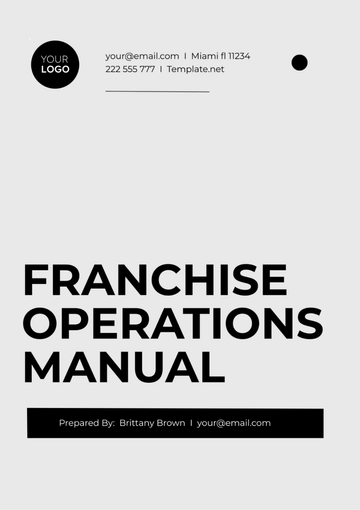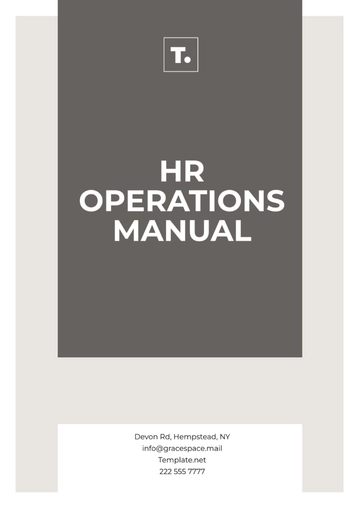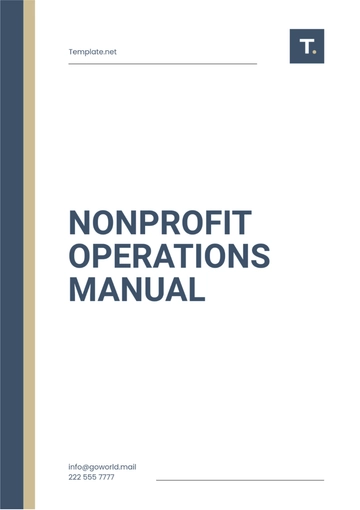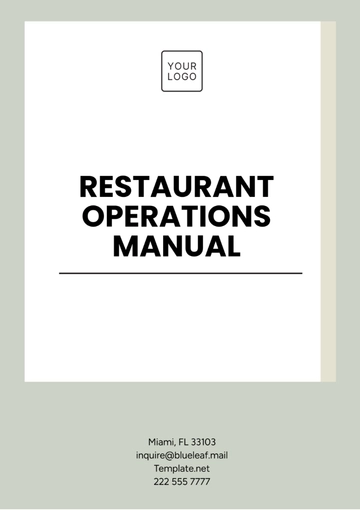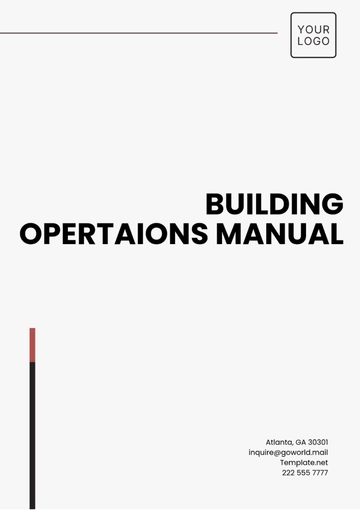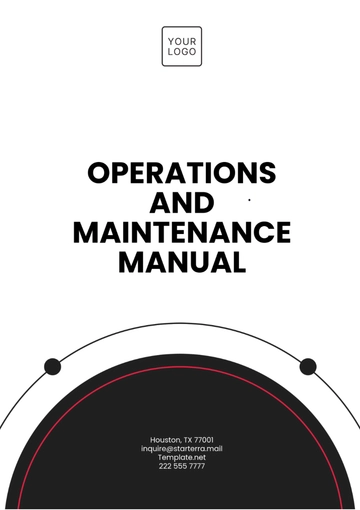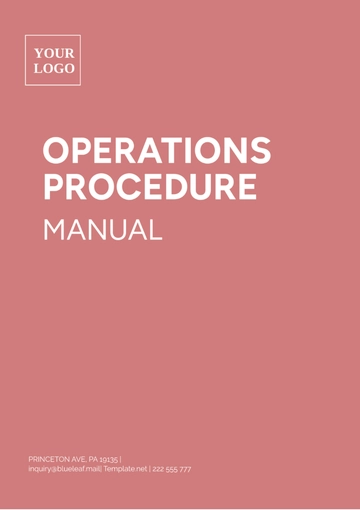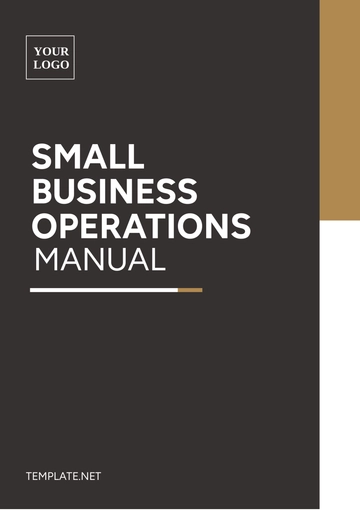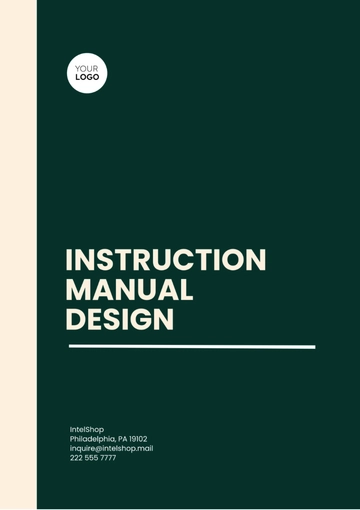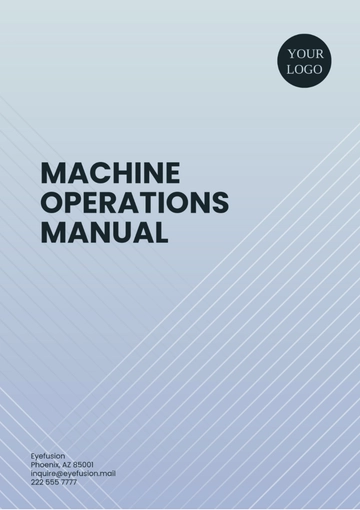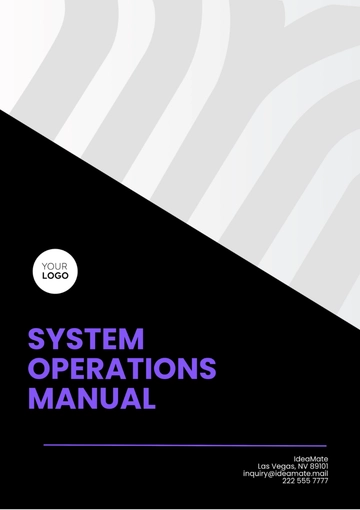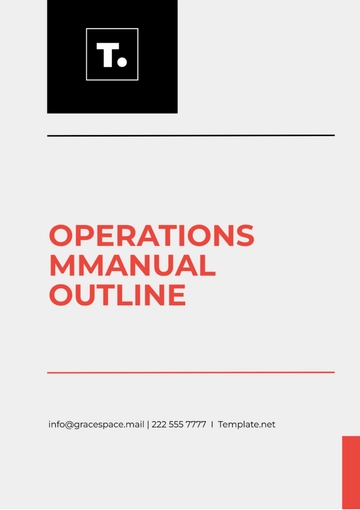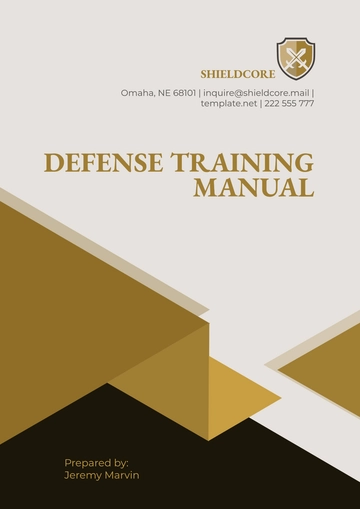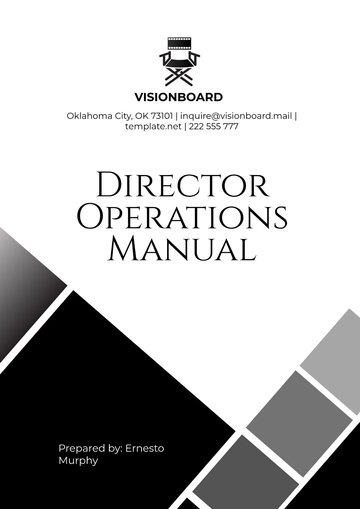Free Grocery Store Logistics Manual

I. Introduction
A. Purpose
Objective: The purpose of this Grocery Store Logistics Manual is to provide a comprehensive guide to the logistics processes at [Your Company Name]. It aims to ensure smooth and efficient operations within the grocery store.
Alignment: This manual aligns with [Your Company Name]'s overall mission to provide high-quality products and services to our customers. By following the guidelines, employees can contribute to maintaining high operational standards.
Improvement: Additionally, the manual aims to identify areas for improvement and streamline existing processes to enhance productivity and customer satisfaction.
B. Scope
Coverage: This manual covers all logistics-related activities, including inventory management, receiving goods, storage procedures, order fulfillment, and transportation.
Applicability: The procedures and guidelines are applicable to all logistics staff, including warehouse personnel, inventory managers, and transportation coordinators.
C. Target Audience
Employees: The primary audience for this manual is the logistics staff of [Your Company Name], including new hires and existing employees looking for a reference.
Management: Store managers and supervisors will also find this manual useful for overseeing logistics operations and ensuring compliance with established procedures.
Stakeholders: Secondary audiences include other stakeholders such as suppliers and partners who may need to understand the store’s logistics processes.
II. Inventory Management
The following table provides an overview of the steps involved in inventory management:
No. | Step | Description |
|---|---|---|
1 | Inventory Assessment | Regularly check stock levels and product quality. |
2 | Stock Replenishment | Order new stock based on inventory assessment. |
3 | Receiving Goods | Check and record incoming stock. |
4 | Storage Procedures | Store goods appropriately based on type. |
5 | Stock Rotation | Rotate stock to ensure older items are sold first. |
A. Inventory Assessment
Frequency: Conduct inventory assessments weekly to monitor stock levels and product quality. This helps in identifying low-stock items and potential issues with inventory.
Method: Use both manual counts and inventory management software to ensure accuracy. Combining both methods minimizes errors and provides a comprehensive view of stock status.
Reporting: Document findings in an inventory report, highlighting critical shortages and overstocked items. This report should be reviewed by inventory managers for action.
Quality Checks: Assess the quality of products during inventory checks to ensure items meet [Your Company Name]'s standards. Identify and remove any damaged or expired items.
Adjustment: Adjust inventory records based on the assessment to reflect accurate stock levels. Update the system immediately to prevent discrepancies.
Regular inventory assessments are crucial for maintaining optimal stock levels and ensuring product quality. Accurate assessments help in timely stock replenishment and prevent overstocking, reducing storage costs.
B. Stock Replenishment
Ordering: Place orders for new stock based on the inventory assessment. Use sales forecasts and historical data to determine the quantities needed.
Supplier Coordination: Coordinate with suppliers to ensure timely delivery of orders. Establish strong relationships with key suppliers for reliable stock replenishment.
Budgeting: Manage the budget for stock replenishment to avoid overspending. Monitor spending and adjust orders as necessary to stay within budget limits.
Lead Time: Consider supplier lead times when placing orders. Ensure orders are placed well in advance to account for delivery times and avoid stockouts.
Timely stock replenishment ensures that the store remains well-stocked with popular and essential items. Effective coordination with suppliers and budget management are key components of this process.
C. Receiving Goods
Inspection: Inspect incoming goods for quantity and quality. Verify that the received items match the order specifications and check for any damages.
Documentation: Record the receipt of goods in the inventory system. Include details such as the delivery date, supplier name, and quantity received.
Quality Control: Conduct quality control checks on incoming goods. Ensure that items meet the store’s standards before they are added to inventory.
Discrepancies: Address any discrepancies between the order and received goods immediately. Report issues to the supplier and arrange for replacements or refunds if necessary.
Proper receiving procedures are essential to maintain accurate inventory records and ensure the quality of products. Addressing discrepancies promptly helps maintain good supplier relationships.
D. Storage Procedures
Categorization: Store goods based on their type and category. Ensure that similar items are grouped together for easy access and inventory management.
Temperature Control: For perishable items, store goods in temperature-controlled environments to maintain freshness and prevent spoilage.
Safety: Follow safety protocols when storing hazardous materials. Ensure that these items are stored separately and clearly labeled.
Accessibility: Arrange storage areas to ensure easy access for inventory checks and stock rotation. Maintain clear paths and organized shelves.
Effective storage procedures help in maintaining product quality and ensuring easy access to goods. Proper categorization and temperature control are critical for perishable items.
E. Stock Rotation
FIFO Method: Implement the First-In-First-Out (FIFO) method to ensure older stock is sold before newer stock. This helps in reducing waste and maintaining product freshness.
Shelf Life Monitoring: Monitor the shelf life of products and prioritize the sale of items nearing their expiration dates. Regular checks are essential to prevent the sale of expired goods.
Reorganization: Regularly reorganize storage areas to facilitate stock rotation. Ensure that newer stock is placed behind older stock on shelves.
Training: Train staff on the importance of stock rotation and proper techniques. Ensure that all employees understand and follow the stock rotation procedures.
Stock rotation is vital for maintaining the freshness and quality of products. Implementing the FIFO method and monitoring shelf life helps in reducing waste and ensuring customer satisfaction.
III. Order Fulfillment
The following table provides an overview of the steps involved in order fulfillment:
No. | Step | Description |
|---|---|---|
1 | Order Processing | Receive and process customer orders. |
2 | Picking and Packing | Select and pack items for delivery. |
3 | Shipping | Arrange for delivery to customers. |
4 | Delivery | Ensure timely and accurate delivery of orders. |
5 | Customer Feedback | Collect feedback to improve service. |
A. Order Processing
Order Entry: Enter customer orders into the system accurately and promptly. Verify customer details and order specifics to avoid errors.
Verification: Verify the availability of ordered items in the inventory. Confirm the order with the customer and provide an estimated delivery time.
Payment Processing: Process payments securely and efficiently. Ensure that payment confirmation is received before proceeding with order fulfillment.
Order Confirmation: Send order confirmation to the customer, including order details and expected delivery date. Maintain clear communication with the customer throughout the process.
Accurate order processing is essential for meeting customer expectations and ensuring a smooth fulfillment process. Efficient payment processing and clear communication contribute to customer satisfaction.
B. Picking and Packing
Picking: Select items from the inventory based on the order details. Ensure that the correct quantities and products are picked to fulfill the order.
Quality Check: Conduct a quality check on the picked items to ensure they are in good condition and match the order specifications.
Packing: Pack items securely to prevent damage during transit. Use appropriate packaging materials and label packages correctly.
Documentation: Include necessary documentation with the package, such as invoices, delivery notes, and return instructions. Ensure that all paperwork is accurate and complete.
Efficient picking and packing processes ensure that orders are fulfilled accurately and securely. Proper documentation and quality checks help in maintaining customer trust and satisfaction.
C. Shipping
Carrier Selection: Choose reliable carriers for shipping orders. Consider factors such as delivery speed, cost, and service reliability when selecting carriers.
Scheduling: Schedule shipments to ensure timely delivery. Coordinate with carriers to optimize delivery routes and times.
Tracking: Provide customers with tracking information for their orders. Ensure that they can monitor the progress of their shipment in real-time.
Handling Special Requirements: Handle any special shipping requirements, such as expedited delivery or fragile items, with care. Communicate any additional costs or considerations to the customer.
Effective shipping processes are crucial for ensuring that orders are delivered on time and in good condition. Providing tracking information and handling special requirements contribute to a positive customer experience.
D. Delivery
Timeliness: Ensure that deliveries are made within the promised timeframe. Monitor delivery schedules and address any delays promptly.
Accuracy: Verify that the correct items and quantities are delivered to the customer. Double-check order details before finalizing the delivery.
Customer Interaction: Interact with customers professionally and courteously during delivery. Address any questions or concerns they may have.
Feedback Collection: Collect feedback from customers regarding their delivery experience. Use this feedback to improve future delivery processes.
Timely and accurate deliveries are essential for maintaining customer satisfaction. Professional customer interactions and feedback collection help in identifying areas for improvement.
E. Customer Feedback
Feedback Channels: Provide multiple channels for customers to provide feedback, such as online surveys, email, and phone. Make it easy for customers to share their experiences.
Response Time: Respond to customer feedback promptly. Address any issues or concerns raised by customers to maintain trust and loyalty.
Analysis: Analyze feedback to identify common trends and areas for improvement. Use this analysis to inform changes to order fulfillment processes.
Continuous Improvement: Implement changes based on customer feedback to continuously improve the order fulfillment process. Regularly review and update procedures to meet evolving customer needs.
Collecting and analyzing customer feedback is vital for improving order fulfillment processes. Responding to feedback promptly and making necessary adjustments helps in maintaining high customer satisfaction levels.
IV. Transportation Management
The following table provides an overview of the steps involved in transportation management:
No. | Step | Description |
|---|---|---|
1 | Route Planning | Plan efficient delivery routes. |
2 | Vehicle Maintenance | Ensure vehicles are well-maintained. |
3 | Driver Management | Manage driver schedules and performance. |
4 | Load Optimization | Optimize loads to maximize vehicle capacity. |
5 | Compliance | Ensure compliance with transportation regulations. |
A. Route Planning
Efficiency: Plan delivery routes to minimize travel time and fuel consumption. Use route planning software to optimize delivery schedules and paths.
Customer Requirements: Consider customer delivery preferences and requirements when planning routes. Ensure that delivery times meet customer expectations.
Traffic Conditions: Monitor traffic conditions and adjust routes as necessary to avoid delays. Use real-time traffic data to make informed decisions.
Contingency Plans: Develop contingency plans for unexpected events, such as road closures or vehicle breakdowns. Ensure that alternative routes are available.
Effective route planning helps in reducing transportation costs and improving delivery efficiency. Considering customer requirements and traffic conditions ensures timely deliveries.
B. Vehicle Maintenance
Regular Inspections: Conduct regular inspections of delivery vehicles to ensure they are in good working condition. Identify and address any maintenance issues promptly.
Preventive Maintenance: Implement a preventive maintenance schedule for all vehicles. Regularly check and service critical components to prevent breakdowns.
Record Keeping: Maintain detailed records of all maintenance activities. Ensure that documentation is complete and up-to-date.
Safety Checks: Perform safety checks before each trip to ensure that vehicles are safe to operate. Address any safety concerns immediately.
Proper vehicle maintenance is essential for ensuring the reliability and safety of the transportation fleet. Regular inspections and preventive maintenance help in reducing downtime and repair costs.
C. Driver Management
Scheduling: Create efficient driver schedules to ensure adequate coverage for all delivery routes. Consider factors such as workload and driver availability.
Training: Provide regular training to drivers on safe driving practices and customer service. Ensure that drivers are knowledgeable about company policies and procedures.
Performance Monitoring: Monitor driver performance through regular evaluations and feedback. Address any performance issues promptly and provide additional training as needed.
Compliance: Ensure that drivers comply with all transportation regulations, including hours of service and safety standards. Regularly review compliance records and address any issues.
Effective driver management is crucial for maintaining a reliable and professional transportation service. Regular training and performance monitoring help in improving driver performance and customer satisfaction.
D. Load Optimization
Capacity Utilization: Optimize vehicle loads to maximize capacity and reduce the number of trips. Ensure that loads are distributed evenly to prevent overloading.
Weight Limits: Adhere to vehicle weight limits to ensure safe and legal operation. Avoid exceeding weight limits to prevent fines and damage to vehicles.
Loading Procedures: Follow proper loading procedures to ensure that goods are secured and protected during transit. Use appropriate equipment and techniques to load and unload goods safely.
Efficiency: Aim for efficient loading and unloading processes to minimize downtime. Ensure that loading areas are well-organized and equipped with necessary tools.
Optimizing loads helps in reducing transportation costs and improving efficiency. Adhering to weight limits and proper loading procedures ensures safe and legal operations.
E. Compliance
Regulations: Stay updated on transportation regulations and ensure compliance with all applicable laws. Regularly review and update policies to reflect changes in regulations.
Documentation: Maintain accurate and complete documentation for all transportation activities. Ensure that records are readily available for inspections and audits.
Training: Provide regular training to drivers and staff on regulatory requirements. Ensure that all employees are aware of and comply with transportation regulations.
Audits: Conduct regular audits of transportation activities to ensure compliance with regulations. Address any issues identified during audits promptly.
Compliance with transportation regulations is essential for avoiding fines and ensuring safe operations. Regular training and audits help in maintaining compliance and addressing any issues.
V. Supplier Management
The following table provides an overview of the steps involved in supplier management:
No. | Step | Description |
|---|---|---|
1 | Supplier Selection | Choose reliable suppliers based on criteria. |
2 | Contract Negotiation | Negotiate favorable terms and conditions. |
3 | Performance Monitoring | Monitor supplier performance regularly. |
4 | Relationship Management | Maintain strong relationships with suppliers. |
5 | Issue Resolution | Address and resolve supplier-related issues. |
A. Supplier Selection
Criteria: Establish clear criteria for selecting suppliers, such as product quality, reliability, and cost. Use these criteria to evaluate potential suppliers.
Evaluation: Conduct thorough evaluations of potential suppliers. Consider factors such as their reputation, financial stability, and ability to meet delivery schedules.
Approval: Approve suppliers that meet the established criteria. Ensure that they understand and agree to [Your Company Name]'s standards and requirements.
Onboarding: Onboard new suppliers by providing them with necessary information and training. Ensure that they are familiar with company policies and procedures.
Selecting reliable suppliers is crucial for maintaining a steady supply of high-quality products. Thorough evaluations and clear criteria help in choosing the best suppliers for the business.
B. Contract Negotiation
Terms and Conditions: Negotiate favorable terms and conditions with suppliers. Consider factors such as pricing, payment terms, delivery schedules, and return policies.
Agreement: Draft and finalize supplier agreements that clearly outline the terms and conditions. Ensure that both parties understand and agree to the contract terms.
Flexibility: Build flexibility into contracts to allow for adjustments as needed. This may include provisions for price changes, delivery delays, and other unforeseen circumstances.
Documentation: Maintain detailed records of all contract negotiations and agreements. Ensure that contracts are easily accessible for reference and review.
Effective contract negotiation helps in securing favorable terms with suppliers and ensuring a smooth supply chain. Clear agreements and flexibility in contracts contribute to long-term supplier relationships.
C. Performance Monitoring
Metrics: Establish key performance metrics to monitor supplier performance. These may include delivery times, product quality, order accuracy, and responsiveness.
Regular Reviews: Conduct regular performance reviews with suppliers. Use the established metrics to evaluate their performance and identify areas for improvement.
Feedback: Provide constructive feedback to suppliers based on performance reviews. Address any issues promptly and work collaboratively to resolve them.
Continuous Improvement: Encourage suppliers to continuously improve their performance. Work with them to implement changes and achieve better results.
Regular performance monitoring ensures that suppliers meet [Your Company Name]'s standards and requirements. Constructive feedback and continuous improvement contribute to stronger supplier relationships.
D. Relationship Management
Communication: Maintain open and regular communication with suppliers. Ensure that both parties are aware of expectations, changes, and any issues that arise.
Collaboration: Collaborate with suppliers on joint projects and initiatives. This may include product development, process improvements, and sustainability efforts.
Support: Provide support to suppliers as needed. This may include sharing best practices, providing training, and offering resources to help them improve their performance.
Trust Building: Build trust with suppliers through transparency and reliability. Honor commitments, provide timely payments, and address concerns promptly.
Strong supplier relationships are essential for a reliable supply chain. Open communication, collaboration, and support help in building trust and achieving mutual success.
E. Issue Resolution
Identification: Identify supplier-related issues promptly. This may include delivery delays, product defects, or contract breaches.
Investigation: Investigate issues thoroughly to determine the root cause. Gather relevant information and involve all necessary parties.
Resolution: Work with suppliers to develop and implement solutions to resolve issues. Ensure that corrective actions are taken promptly and effectively.
Follow-Up: Follow up on resolved issues to ensure that they do not recur. Monitor the situation and provide additional support if needed.
Documentation: Document all issues and resolutions. Maintain detailed records for future reference and to track supplier performance over time.
Effective issue resolution helps in maintaining strong supplier relationships and ensuring a smooth supply chain. Prompt identification, thorough investigation, and effective resolution are key components of this process.
VI. Inventory Control
The following table provides an overview of the steps involved in inventory control:
No. | Step | Description |
|---|---|---|
1 | Stock Monitoring | Regularly monitor stock levels and movements. |
2 | Reorder Point Setting | Establish reorder points for each product. |
3 | Cycle Counting | Perform cycle counts to verify inventory accuracy. |
4 | Inventory Audits | Conduct periodic inventory audits. |
5 | Shrinkage Control | Implement measures to control inventory shrinkage. |
A. Stock Monitoring
Frequency: Regularly monitor stock levels and movements to ensure accuracy. Use inventory management software for real-time tracking and updates.
Alerts: Set up alerts for low-stock items and critical inventory levels. Ensure that notifications are sent to inventory managers for prompt action.
Analysis: Analyze stock data to identify trends and patterns. Use this information to make informed decisions about stock replenishment and inventory control.
Reporting: Generate regular inventory reports to provide insights into stock levels and movements. Share these reports with relevant stakeholders for review and action.
Accurate stock monitoring is essential for maintaining optimal inventory levels. Real-time tracking and analysis help in making informed decisions and preventing stockouts.
B. Reorder Point Setting
Criteria: Establish reorder points for each product based on sales data, lead times, and safety stock levels. Use historical data to determine the appropriate reorder points.
Review: Regularly review and adjust reorder points as needed. Consider changes in demand, supplier lead times, and other factors that may impact inventory levels.
Automation: Use inventory management software to automate reorder point settings and notifications. Ensure that the system is updated regularly to reflect current inventory levels.
Coordination: Coordinate with suppliers to ensure timely replenishment of stock. Communicate reorder points and lead times to avoid stockouts and delays.
Setting appropriate reorder points helps in maintaining optimal stock levels and ensuring timely replenishment. Regular reviews and automation contribute to efficient inventory control.
C. Cycle Counting
Frequency: Perform cycle counts regularly to verify inventory accuracy. Schedule counts based on product categories and inventory turnover rates.
Methodology: Use a systematic approach for cycle counting. Divide the inventory into manageable sections and count items in a structured manner.
Accuracy: Ensure accuracy in cycle counts by double-checking counts and resolving discrepancies promptly. Use barcode scanners and other tools to enhance accuracy.
Reporting: Document cycle count results and share them with inventory managers. Use the data to update inventory records and address any discrepancies.
Regular cycle counting helps in maintaining accurate inventory records and identifying discrepancies. A systematic approach and accurate counts contribute to efficient inventory control.
D. Inventory Audits
Frequency: Conduct periodic inventory audits to verify the accuracy of inventory records. Schedule audits at least annually or as needed based on business requirements.
Scope: Define the scope of the inventory audit, including the products and locations to be audited. Ensure that the audit covers all critical inventory areas.
Process: Follow a structured process for inventory audits, including planning, execution, and reporting. Use standardized audit checklists and procedures.
Follow-Up: Follow up on audit findings to address any discrepancies or issues. Implement corrective actions and monitor progress to ensure resolution.
Documentation: Maintain detailed records of inventory audits, including findings and corrective actions. Use the data to improve inventory control processes.
Periodic inventory audits are essential for verifying inventory accuracy and identifying areas for improvement. A structured process and thorough documentation contribute to effective inventory control.
E. Shrinkage Control
Identification: Identify the sources of inventory shrinkage, such as theft, damage, or administrative errors. Use data analysis and investigations to pinpoint the root causes.
Prevention: Implement measures to prevent inventory shrinkage, such as security systems, employee training, and improved inventory handling procedures.
Monitoring: Regularly monitor inventory shrinkage and track progress. Use inventory management software to identify trends and measure the effectiveness of prevention measures.
Reporting: Document inventory shrinkage incidents and share reports with relevant stakeholders. Use the data to make informed decisions and implement corrective actions.
Continuous Improvement: Continuously review and improve shrinkage control measures. Regularly assess the effectiveness of prevention strategies and make necessary adjustments.
Controlling inventory shrinkage is crucial for maintaining accurate inventory records and reducing losses. Effective prevention measures and continuous improvement contribute to efficient inventory control.
VII. Logistics Technology
The following table provides an overview of the steps involved in logistics technology:
No. | Step | Description |
|---|---|---|
1 | Technology Assessment | Evaluate current technology and identify needs. |
2 | System Implementation | Implement new logistics technology solutions. |
3 | Training and Support | Provide training and support for technology use. |
4 | Data Management | Ensure accurate and secure data management. |
5 | Continuous Improvement | Continuously improve and update technology. |
A. Technology Assessment
Evaluation: Evaluate the current logistics technology used by [Your Company Name]. Identify strengths, weaknesses, and areas for improvement.
Needs Assessment: Conduct a needs assessment to determine the technology requirements for efficient logistics operations. Consider factors such as scalability, functionality, and integration.
Benchmarking: Compare the current technology with industry standards and best practices. Identify gaps and opportunities for improvement.
Recommendations: Develop recommendations for technology upgrades or new solutions based on the assessment findings. Prioritize recommendations based on impact and feasibility.
Evaluating and assessing logistics technology is crucial for identifying areas for improvement and ensuring efficient operations. A thorough needs assessment and benchmarking help in making informed decisions.
B. System Implementation
Planning: Develop a detailed implementation plan for new logistics technology solutions. Define the scope, timeline, and resources required for implementation.
Customization: Customize the technology solutions to meet the specific needs of [Your Company Name]. Ensure that the solutions are tailored to the business processes and requirements.
Testing: Conduct thorough testing of the new technology solutions to ensure they work as expected. Identify and address any issues or bugs before full deployment.
Deployment: Deploy the new technology solutions in a phased manner. Monitor the deployment process and provide support to ensure a smooth transition.
Implementing new logistics technology solutions requires careful planning, customization, and testing. A phased deployment and ongoing support help in ensuring successful implementation.
C. Training and Support
Training Programs: Develop and deliver training programs for employees on the use of new logistics technology solutions. Ensure that training is comprehensive and covers all necessary aspects.
User Guides: Provide user guides and documentation to support employees in using the new technology. Ensure that the guides are clear and easy to understand.
Support Services: Establish support services to assist employees with any issues or questions related to the new technology. Provide timely and effective support to ensure smooth operations.
Feedback: Collect feedback from employees on the new technology and training programs. Use the feedback to improve training and support services.
Effective training and support are essential for ensuring that employees can use new logistics technology solutions efficiently. Comprehensive training programs and support services contribute to successful technology adoption.
D. Data Management
Accuracy: Ensure that all logistics data is accurate and up-to-date. Use data validation and verification processes to maintain data integrity.
Security: Implement robust security measures to protect logistics data from unauthorized access and breaches. Use encryption, access controls, and regular security audits.
Integration: Ensure seamless integration of logistics technology solutions with other business systems. Use standardized data formats and interfaces to facilitate integration.
Reporting: Develop and maintain accurate and timely reports based on logistics data. Use the reports to make informed decisions and improve operations.
Compliance: Ensure compliance with data protection regulations and industry standards. Regularly review and update data management practices to maintain compliance.
Accurate and secure data management is essential for efficient logistics operations. Effective data integration, reporting, and compliance contribute to informed decision-making and operational efficiency.
E. Continuous Improvement
Monitoring: Regularly monitor the performance of logistics technology solutions. Use key performance indicators (KPIs) and metrics to evaluate effectiveness.
Feedback: Collect feedback from employees and stakeholders on the technology solutions. Use the feedback to identify areas for improvement and implement changes.
Updates: Stay updated on the latest advancements in logistics technology. Regularly update and upgrade technology solutions to maintain competitiveness and efficiency.
Innovation: Encourage innovation and experimentation with new technology solutions. Explore new opportunities and pilot new technologies to improve logistics operations.
Review: Conduct regular reviews of logistics technology solutions to ensure they continue to meet the needs of [Your Company Name]. Make necessary adjustments based on the review findings.
Continuous improvement of logistics technology is crucial for maintaining efficiency and competitiveness. Regular monitoring, feedback, updates, and innovation contribute to ongoing technology advancements.
VIII. Sustainability in Logistics
A. Environmental Impact
Assessment: Conduct an assessment of the environmental impact of logistics operations. Identify areas where improvements can be made to reduce the impact.
Emissions: Monitor and measure emissions from transportation and other logistics activities. Use the data to develop strategies for reducing emissions.
Resource Usage: Analyze the usage of resources such as fuel, energy, and water in logistics operations. Identify opportunities for reducing resource consumption.
Waste Management: Implement effective waste management practices to reduce, reuse, and recycle waste generated in logistics operations.
Assessing the environmental impact of logistics operations is crucial for identifying areas for improvement. Monitoring emissions, resource usage, and waste management help in developing sustainable strategies.
B. Green Practices
Transportation: Implement green transportation practices such as using fuel-efficient vehicles, optimizing routes, and adopting alternative fuels. Consider options like electric or hybrid vehicles.
Packaging: Use eco-friendly packaging materials and reduce packaging waste. Implement practices such as reusable packaging and minimizing packaging sizes.
Facilities: Implement energy-efficient practices in logistics facilities. Use renewable energy sources, optimize lighting and HVAC systems, and reduce water usage.
Supply Chain: Collaborate with suppliers and partners to implement sustainable practices across the supply chain. Encourage them to adopt green practices and reduce their environmental impact.
Implementing green practices in transportation, packaging, facilities, and the supply chain helps in reducing the environmental impact of logistics operations. Collaboration with partners and suppliers contributes to broader sustainability efforts.
C. Sustainability Goals
Setting Goals: Set clear and achievable sustainability goals for logistics operations. Consider factors such as emission reductions, resource conservation, and waste reduction.
Action Plans: Develop action plans to achieve sustainability goals. Define specific steps, timelines, and responsibilities for each goal.
Measurement: Measure progress towards sustainability goals using relevant metrics. Track and report progress regularly to ensure accountability.
Adjustment: Adjust action plans and goals as needed based on progress and changing conditions. Ensure that sustainability goals remain relevant and achievable.
Setting and achieving sustainability goals helps in making logistics operations more environmentally friendly. Clear goals, action plans, measurement, and adjustments ensure continuous progress.
D. Reporting and Metrics
Tracking: Track sustainability metrics such as emissions, resource usage, and waste generation. Use data management systems to collect and analyze the data.
Reporting: Develop regular sustainability reports to share progress and achievements with stakeholders. Ensure that reports are accurate, transparent, and comprehensive.
Benchmarking: Compare sustainability performance with industry benchmarks and best practices. Identify areas for improvement and set new targets based on benchmarking results.
Certification: Pursue sustainability certifications and standards to demonstrate commitment to environmental responsibility. Consider certifications such as ISO 14001 for environmental management systems.
Accurate tracking and reporting of sustainability metrics are essential for demonstrating progress and accountability. Benchmarking and certification contribute to continuous improvement and credibility.
IX. Frequently Asked Questions (FAQs)
Q: How often should stock monitoring be conducted?
A: Stock monitoring should be conducted regularly, with real-time tracking and updates through inventory management software. Alerts should be set for low-stock items and critical inventory levels.
Q: What are reorder points, and how are they determined?
A: Reorder points are predefined stock levels at which new inventory orders should be placed to replenish stock. They are determined based on sales data, lead times, and safety stock levels, and should be reviewed and adjusted regularly.
Q: What is cycle counting, and why is it important?
A: Cycle counting is a process of regularly counting a subset of inventory to verify accuracy and identify discrepancies. It helps maintain accurate inventory records and is essential for efficient inventory control.
Q: How can we reduce inventory shrinkage?
A: Inventory shrinkage can be reduced by identifying sources such as theft, damage, or errors, implementing security measures, training employees, and regularly monitoring and reporting shrinkage incidents.
Q: What is the role of logistics technology in our operations?
A: Logistics technology plays a crucial role in improving efficiency through technology assessment, system implementation, training, data management, and continuous improvement, ensuring seamless operations and informed decision-making.
Q: What steps are involved in implementing new logistics technology?
A: Implementing new logistics technology involves planning, customization, testing, phased deployment, and providing ongoing support and training to employees to ensure a smooth transition and successful adoption.
Q: How do we ensure accurate and secure data management in logistics?
A: Accurate and secure data management is ensured through data validation, robust security measures, seamless integration with other systems, timely reporting, and compliance with data protection regulations.
Q: Why is sustainability important in logistics, and how do we achieve it?
A: Sustainability is important in logistics to minimize environmental impact. It is achieved through assessing environmental impact, implementing green practices, setting sustainability goals, tracking and reporting metrics, and continuously improving practices.
- 100% Customizable, free editor
- Access 1 Million+ Templates, photo’s & graphics
- Download or share as a template
- Click and replace photos, graphics, text, backgrounds
- Resize, crop, AI write & more
- Access advanced editor
Optimize your logistics operations with the Grocery Store Logistics Manual Template from Template.net! This template is customizable, allowing you to adapt it to your store's logistics processes. It is also editable, making updates simple and efficient. The AI Editor Tool ensures your logistics manual is thorough and easy to edit!
